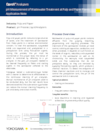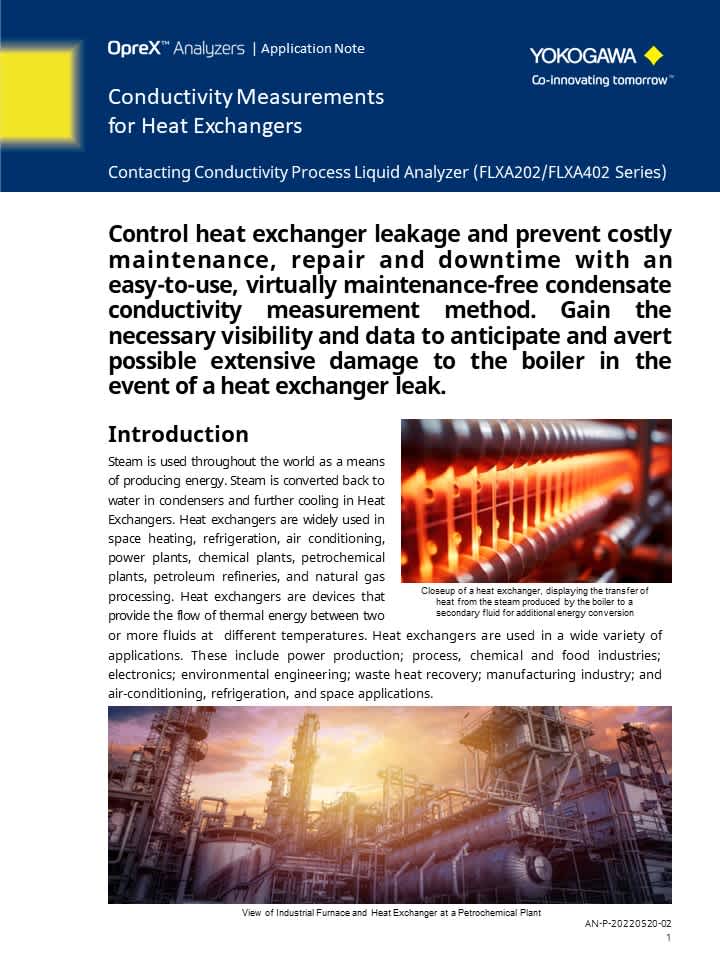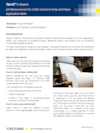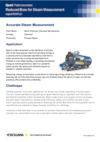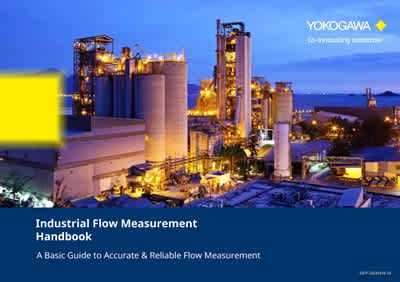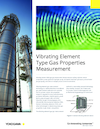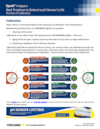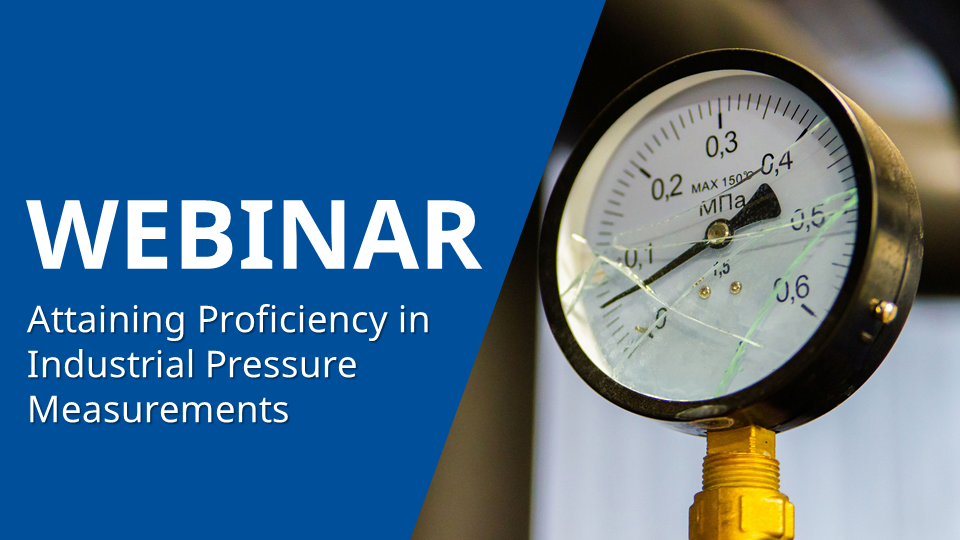Leaders in Precision Measurements & Control Efficiency
 The paper and pulp industry is highly competitive and must meet ever-changing market needs. Yokogawa helps realize energy-efficient plants which are globally sustainable. The demanding applications and severe process conditions in pulp mills pose challenges for accurate, repeatable, and reliable liquid analysis measurements.
The paper and pulp industry is highly competitive and must meet ever-changing market needs. Yokogawa helps realize energy-efficient plants which are globally sustainable. The demanding applications and severe process conditions in pulp mills pose challenges for accurate, repeatable, and reliable liquid analysis measurements.
By combining the field-proven superior design of application-specific technology, Yokogawa’s solutions provide the functionality and the flexibility to adapt quickly to the changing industry requirements; while guaranteeing performance throughout the lifecycle of the process measurement even for the dirtiest applications lies in your hands.
Application Understanding and Expertise
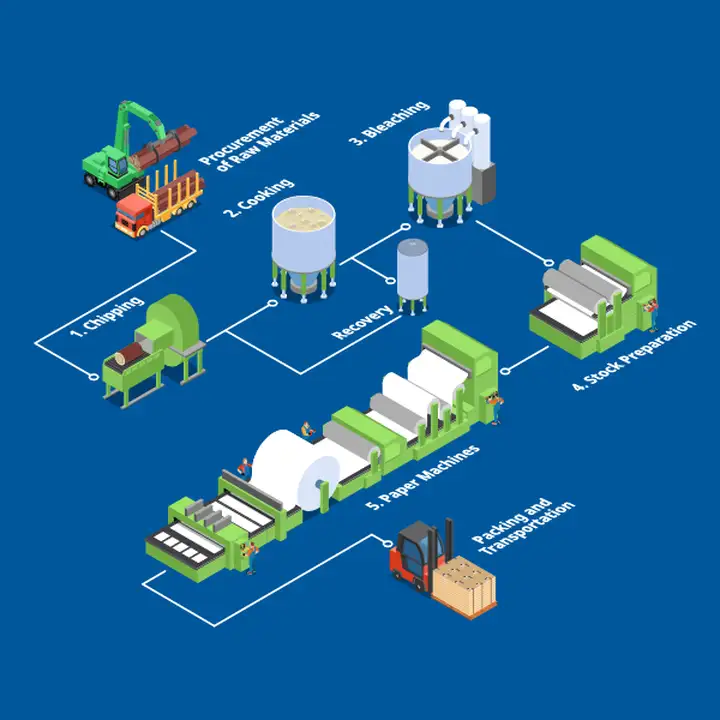 |
Dedicated support staff and regional support specialists are available to help you tailor the appropriate products to your application needs. |
Upcoming Events
-
Event Mar 26 - Dec 31, 2025 CENTUM 50th Anniversary
Marking its 50th anniversary, CENTUM—introduced by Yokogawa in 1975 as the world’s first distributed control system—has continually advanced as a foundational platform for plant monitoring and control, renowned for its reliability, stability, and compatibility.
Details
Solutions
Yokogawa delivers measurement and instrumentation devices that offer extreme precision with dependable measurement accuracy, application flexibility, reliability, and serviceability. Creating value for you in both time and money savings.
 |
 |
 |
||
Verified Performance“Unnoticed problems upstream can cause irreversible problems for me downstream.” “Failure with instruments in service can cause loss of product or quality problems for me.” |
Designed to Last“I just need to keep the instrument running. I worry about unplanned outages.” “I worry about plant obsolescence and the costs of keeping plant instrumentation and control systems current.” "We use old technology because we can't seem to justify the upgrade." |
Plant Wide Integration“I worry about plant obsolescence and the costs of keeping plant instrumentation and control systems current.” "I am concerned with the plant engineering resources utilized to make modifications or maintain the systems. There just is not enough people." |

Verified Performance
Total Insight is a Yokogawa concept for optimizing operations and reducing maintenance costs through every phase of the product lifecycle. The real-time diagnostics and sensor wellness for early detection of sensor failure and replacement enable you to have a more pro-active maintenance schedule. No more unplanned outages.
Designed to Last
Yokogawa’s field-proven instrument can withstand the severe process conditions like high temperatures and abrasive slurries pose, without reducing the accuracy, repeatability, and reliability for the most critical measurements. Dedicated support staff and regional support specialists are available to help you tailor the appropriate products to your toughest application needs.
 |
Field Instrumentation Maximize your plant’s profitability through digitized process measurement solutions that alleviate cost pressures, increase availability and reliability, and improve safety. Learn more |
 |
Process Analyzers and Integrated Analyzer Systems Yokogawa’s analyzers and systems ensure accurate, repeatable measurements for asset management, process optimization, and regulation compliance. Learn more |
Plant Wide Integration
|
It is a well-known fact that plant data is the basis for all solutions in the process industry. As such, data must be easily captured and accessible to ensure long-term improvement opportunities. Based on open standards, Yokogawa's data historian and PIMS solution capture data easily to provide a valuable bedrock. Our solution is especially unique in that implementation costs are significantly reduced when compared to the alternatives. |
 |
Cooking (Digester) Process
|
This is the important step of all cellulose processes, as the better the chips are cooked in the process, the less lignin in the pulp. This results in more efficiency in the final steps of the process, which will save money and customer operation time. Many measurements are used in the digester such as pressure, temperature, and conductivity, but the most problematic for operators are the flow measurements. Challenges |
||||
|
|
Taking flow measurements often becomes very complicated due to:
Talking conductivity measurements often becomes very complicated due to:
|
|||
Solution |
||
|
Earth Rings Minimizes lining abrasion from a slurry fluid
Welded Punch Plate Prevents lining deforming at high temperature |
 |
PFA Lining, Electrode Maintains sealing performance when the lining encounters abrasion from a slurry fluid
Epoxy Potting Increases heat dissipation for high-temperature fluid measurement. Prevents the outflow of fluid when fluid leaks from the electrode. |
| BACK TO TOP | ||
|---|---|---|
Recovery Plant
|
|
|||
ChallengesTaking flow measurements often becomes very complicated due to:
|
SolutionIn a lime kiln, the control can be complicated as several elements need to be maintained to provide the proper and efficient drying. As the size of the kiln increases the more critical the items are. The control of the burner is paramount. It has to be hot enough to ensure that the lime mud is dry by the time it reaches the end of the kiln but not too hot that refractory damage could occur and poor product quality. The length of the flame in the cylinder directly affects these issues. There are two considerations in managing flame length, the amount for fuel supplied to the burner and the amount of air generated by the primary air and induced draft fans. These fans together control the total production capacity of the kiln, how far the flame is thrown into the kiln, and its shape. |
||
|
|
|
||
| BACK TO TOP | |||
|---|---|---|---|
Washing & Bleaching Process
WashingAfter the screening process, the washing process uses chemicals to help reduce the lignin and substances (black liquor) in the pulp. This stage’s objective is to remove the maximum amount of black liquor dissolved solids from the pulp while using as little water as possible. The remaining solids and chemicals in the pulp will interfere with later bleaching and other steps, increasing the cost of the final process. Normally the process has 3 or 4 washing stages in series. The same washing process is located after the oxygen delignification process and after the bleaching stages, as well. The lignin in the pulp will result in a bad quality of paper (in the case of the final product), because the lignin over time will oxidize in contact with the air, and this is what makes the paper looks “yellowish”. Excellent paper quality will keep the bright and white aspect as a lower quantity of lignin remains in the final product. |
BleachingThe objective of the bleaching process is to remove only the chromophores (elements that provide color). This is possible because the structures responsible for color are also more susceptible to the oxidation and reduction process. In the bleaching process oxygen, hydrogen peroxide, ozone, and caustic Soda are used to reduce the lignin, but keep the integrity of cellulose fibers. The combination of these chemicals and the sequence of these steps will depend on each customer’s required level of brightness in the final product. Most facilities use the following process and wash with sodium hydroxide, then treated in sequence with alkaline peroxide and sodium dithionite. Many measurements are used to monitor the process such as pressure, temperature, and flow. However, the process of bleaching highly depends on accurate pH/ORP measurements. |
||||||
ChallengesTaking pH/ORP measurements often becomes very complicated due to:
|
|
||||||
SolutionThe best fit pH solution is not a one size fits all. Yokogawa’s experts work side-by-side with each plant operator to determine which solution best aligns with their goals and existing installation constraints. |
|||||||
|
|
|
||||||
|
Maintenance Manager > |
 |
< Process Guard |
|||||
| BACK TO TOP | |||||||
|---|---|---|---|---|---|---|---|
Stock Preparation & Paper Machine
|
Immediately after the washing and bleaching section, the white pulp is further refined to specific specifications and consistencies in cleaning, storage, and blending chests before it is introduced to the headbox of the paper machine. During each of these operations, additives such as resins, paper sizing materials, and colorants are blended into the pulp to meet customer specifications for fiber binding, wet tensile strength characteristics, and color in the finish paper sheet. As the paper stocks consistency has been significantly reduced through dilution of the pulp prior to the headbox, significant amounts of white water are removed as the pulp is applied to the Fourdrinier (wire bed immediately after the headbox) and as the sheet moves towards the drying section of the paper machine. Flow is commonly measured on the pulp stock into the headbox and on the white water lines; while level and pressure transmitters are used in the paper machine. The most critical measurement depends on accurate pH/ORP measurements. |
|
ChallengesTaking pH/ORP measurements often becomes very complicated due to:
Prior to the headbox, the tolerances allowed for pH can be relatively wide, in many cases +/- 1-2 pH units. However, at the headbox, the pH must be tightly controlled to typically within +/- 0.2-0.4 pH units. pH control at the headbox is normally achieved with the addition of alum or soda ash. Both are used to control the pH but they are also acting a flocculating agent to precipitate resins during the forming of the sheet of paper on the paper machines wire. The control of pH at this point in the process is critical to the proper formation of the paper and also to prevent excess wear on the paper machine. |
Solutions
|
| BACK TO TOP |
|---|
Resources
PT. Tanjung Enim Lestari Pulp and Paper (PT. TEL) operates a pulp mill in Muara Enim, which is 130 km west of Palembang, the capital of Indonesia's South Sumatra province. This is the only pulp mill in the world to produce high-quality, bleached-hardwood kraft pulp solely from plantation grown Acacia mangium trees.
The replacement of plastic products with paper pulp is rapidly progressing to achieve carbon neutrality.
Bracell uses OpreX LIMS to streamline quality inspection operations for its high-quality cellulose products.
A virtual network system that securely connects OT-IT built on existing network resources.
Yokogawa experts monitor the network remotely like customer's information system department.
- Yokogawa installed a B/M9000CS quality control system with various cross direction profile control functions.
- The installation improves product quality and efficiency at pulp & paper mill.
- Exaquantum Achieves $2 Million in Annual Savings for CENIBRA Pulp & Paper Plant.
- Following an upgrade to the CENTUM CS 3000 Production Control System, leading pulp and paper supplier CENIBRA saw the potential for further savings and efficiencies through tighter control of the production process.
To enable central control of the entire plant, all of its subsystems are integrated with Yokogawa's CENTUM VP DCS.
Yokogawa's unique simultaneous, dual-frequency excitation method used in the ADMAG TI magnetic flowmeter can enable tighter control, faster response, larger quantity of end product per batch, reduced cost, and higher profitability.
As the second largest pulp producer in the world, Brazil is known for producing multiple raw materials, especially eucalyptus. The country’s soil and climate are conducive to the plant’s cultivation, which takes an average of seven years to grow and spends this period absorbing CO2. For every crop cut, new seedlings are planted and more eucalyptus grows, making this a cyclical, sustainable, and cost-competitive business model. The pulp industry also contributes significantly to local employment and the economy, creating a broad supply chain that includes eucalyptus cultivation, chemicals, biotechnology, and transportation.
With the high temperatures, pressures, and levels of dissolved organics that are encountered, the ADMAG AXG flow meter design is ideal for use in all phases of the chemical recovery process.
The treatment of wastewater from pulp and paper plants is a serious environmental concern. Yokogawa's submersion holder with an ultrasonic+air-jet cleaner (customized product) can reduce the manual cleaning frequency to just once every one or two months.
Drying is an important part of the papermaking process that evaporates the remaining water in the wet paper web. This is performed with a dryer, and the humidity control in this dryer is essential to maintaining high paper quality (e.g., strength, paper surface) and high heat energy efficiency.
Ideal for various tank and vessel level measurements, diaphragm seal systems with compensating capillaries set a new standard for high performance, safety, and reliability.
- Oil level measurement of diesel tanks that feed fuel to their diesel generator's which are at three locations and 400 meters apart from each other.
- Also to measure level , pressure and flow to and from their main storage yard.
The kraft process, also known as kraft pulping or the sulfate process, is a technology for conversion of wood into wood pulp that consists of almost pure cellulose fibers. Today, the kraft process is used in approximately 80% of paper production.
Reverse osmosis (RO) is a separation process that uses pressure to force a solution through a membrane that retains the solute on one side and allows the pure solvent to pass to the other side. More formally, it is the process of forcing a solvent from a region of high solute concentration through a membrane to a region of low solute concentration by applying a pressure in excess of the osmotic pressure.
Drying is an important part of the papermaking process that evaporates the remaining water in the wet paper web. This is performed with a dryer, and the humidity control in this dryer is essential to maintaining high paper quality (e.g., strength, paper surface) and high heat energy efficiency.
Heat exchangers are devices that provide the flow of thermal energy between two or more fluids at different temperatures. Heat exchangers are used in a wide variety of applications. These include power production; process, chemical and food industries; electronics; environmental engineering; waste heat recovery; manufacturing industry; and air-conditioning, refrigeration, and space applications. Yokogawa offers a means to control heat exchanger leakage and prevent costly maintenance, repair and downtime with an easy-to-use, virtually maintenance-free condensate conductivity measurement method.
To defray energy costs, many industrial plants have their own boilers to generate steam to produce a portion of their energy needs. In addition to generating power, the steam may also be used directly in plant processes or indirectly via heat exchangers or steam jacketed vessels.
Ion Exchange is a method for the exchange of ions between two electrolytes or between an electrolyte solution and a complex molecule. In most cases the term is used to denote the processes of purification, separation, and decontamination of aqueous and other ion-containing solutions with solid polymeric or mineralic ion exchangers.
Problems at the wet end of a paper machine can rarely be corrected downstream. That is why monitoring and controlling pH in pulp stock is critical to the paper-making process. Essentially, at every stage in the manufacture of paper, correct pH values play a vital role. Variations in the pH value at the headbox have a negative effect on the quality of the paper produced. Proper monitoring ensures minimizing plugging and fouling problems that occur with pH measurements in paper mills.
The quality of paper for printing or writing should be high and it depends on many parameters. Cobb is one of the parameters, which requires control. Using a retractable fitting, this optimum pH level can be achieved by using Yokogawa's 4-wire pH Analyzer with a suitable, retractable fitting and sensor. Since a separate controller is not required for the dosing pump, this solution provides a cost-saving.
Yokogawa's digitalYEWFLO Reduced Bore Type Vortex Flow meter features a cast stainless steel body and a concentric reducer and expander that enable stable flow rate measurements in low-flow conditions. This expands the range of measurements that can be performed, from the higher flow rates down to the lower end of the flow span, which is normally difficult for Vortex Flow meters, and ensures stable and accurate flow rate output.
A belt conveyor fire detection solution employing the DTSX distributed optical fiber temperature sensor can greatly reduce crises that can threaten a company's survival.
With industrial and economic development comes increasingly large and advanced power plants and factories. Nevertheless, we find many cases where the original cables, cable tunnels, and other components of the power infrastructure have languished under continuous operation.
A Basic Guide to Accurate & Reliable Flow Measurement.
In this Yokogawa RAP Best Practices eBook, you’ll discover how our wealth of knowledge about Integrated Safe Systems and Control of Work is available to help you and your teams design and implement a system that best suits your needs.
Visual MESA© is a steam system optimization and management computer program that was originally developed at Chevron and now marketed by Nelson & Roseme, Inc. Visual MESA is currently used at refinery and chemical manufacturing sites to optimize the overall site steam system and the parts of the electrical system that economically trade off with the steam system.
This paper will explore significant optimization variables and constraints commonly encountered in refinery steam system optimization, the strategies Visual MESA uses to deal with them.
This paper will not describe just all the features of the software or fully explain on-line optimization technology. The objective of this work is to present some interesting facts and lessons from the experience of implementing a cost based optimization program at thirty oil refineries and petrochemical complexes, around the world, since 1997. This paper will focus on the key optimization variables and constraints in steam system optimization, how they should be handled and how the human and organizational aspects can be addressed.
The worlds of process automation and production management have been converging for some time. What once used to be islands of automation and production management functionality connected through highly proprietary integration schemes that were costly to maintain have developed into integrated platforms that provide seamless data exchange between the world of automation and the plant floor, the functions of production and operations management, and integration with business level systems.
- Base Chemical
- Biofuel
- Chemical
- Drinking Water Treatment
- Energy Transition
- Food & Beverage
- Geothermal Power
- Iron & Steel
- Offshore (FPSO FLNG & FSRU)
- Oil & Gas
- Oil & Gas Downstream
- Petrochemical
- Pharmaceutical
- Pipeline
- Power Generation
- Pulp & Paper
- Refining
- Thermal
- Upstream
- Wastewater Treatment
- Water & Wastewater
On-site digital champions can drive your operation towards data integration and a more aligned way of working.
The world of process automation is governed by procedures. While we like to refer to the process industries as being largely "continuous", this could not be further from the truth. Process manufacturing is constantly in flux.
- Chemical
- Floating Production Storage & Offloading (FPSO)
- Food & Beverage
- Iron & Steel
- Offshore (FPSO FLNG & FSRU)
- Oil & Gas
- Oil & Gas Downstream
- Oil & Gas Midstream
- Onshore
- Petrochemical
- Pharmaceutical
- Power Generation
- Processing & Fractionation
- Pulp & Paper
- Refining
- Subsea
- Topsides
- Upstream
- Water & Wastewater
Digital twins are dynamic digital representations that enable companies to understand, predict and radically reorient their business processes.
The automation suppliers that will be successful in the long term will be those that effectively address application or industry specific problems for end users with a value proposition that cannot be ignored. These problems exist throughout the process industries today, and they won't be solved by simply offering a product, but through a combination of hardware, software, services, application expertise, and knowledge.
- Biofuel
- Biomass Power
- Chemical
- Drinking Water Treatment
- Energy Transition
- Geothermal Power
- Iron & Steel
- Offshore (FPSO FLNG & FSRU)
- Oil & Gas
- Oil & Gas Downstream
- Petrochemical
- Pharmaceutical
- Pipeline
- Power Generation
- Pulp & Paper
- Refining
- Thermal
- Upstream
- Waste to Energy
- Wastewater Treatment
- Water & Wastewater
In ARC's view, customers need a compelling business value proposition to justify investment in any kind of automation. Vigilance and VigilantPlant were created with this in mind. Yokogawa's vision with VigilantPlant is to create an environment where plant personnel and operators are well informed, alert, and ready to take action.
- Biofuel
- Biomass Power
- Chemical
- Drinking Water Treatment
- Energy Transition
- Geothermal Power
- Iron & Steel
- Offshore (FPSO FLNG & FSRU)
- Oil & Gas
- Oil & Gas Downstream
- Petrochemical
- Pharmaceutical
- Pipeline
- Power Generation
- Pulp & Paper
- Refining
- Thermal
- Upstream
- Waste to Energy
- Wastewater Treatment
- Water & Wastewater
Yokogawa has come a long way in making its message clear to the world of process automation. Last year, the company embarked on a full-scale global marketing campaign to make customers aware of the company's focus on system reliability, security, dependability, and robustness. Dubbed "Vigilance", the campaign created a unified message for the company and greatly helped expand awareness of the Yokogawa brand and corporate philosophy.
Smart devices, like Yokogawa’s line of Total Insight transmitters and flowmeters contribute to Digital Transformation during operations and throughout the lifecycle of the instrument.
Process automation end users are under more pressure than ever to do more with less. The current economic climate means that many automation capital projects are on hold. With capital budgets tighter than ever, users instead focus on operational budgets (where cost cutting is also a key concern), or on automation investments with a very rapid return on investment.
In today's dynamic industrial marketplace, the only constant is change. Raw material costs, energy costs, market demands, environmental and safety regulations, technology, and even the nature of the labor force itself are constantly changing, and not always in predictable directions.
Discovering your Baseline with OT Security Risk Assessment
Vibrating element (VBE) type gas measurement devices measure refinery reformer stream compositions, power generator hydrogen purity, centripetal compressor gas inputs, process heater fuel gas quality, and others in multiple process control environments.
Optimizing the maintenance cycle is not always straightforward. In some cases, cleaning once a week is sufficient and other processes may require every 8 hours.
- Ammonia
- Base Chemical
- Biomass Power
- Chemical
- Chlor-Alkali
- Cogeneration
- Desalination
- Drinking Water Treatment
- Energy Transition
- Food & Beverage
- Geothermal Power
- Hydro Power
- Industrial Water
- Iron & Steel
- LNG Liquefaction
- LNG Regasification & Storage
- LNG Supply Chain
- Methanol
- Mining & Metal
- Nuclear
- Ocean Thermal Energy Conversion
- Oil & Gas Downstream
- Petrochemical
- Pharmaceutical
- Power Generation
- Processing & Fractionation
- Pulp & Paper
- Refining
- Specialty & Fine Chemical
- Water & Wastewater
Learning these four lessons will help you improve your engineering skills and most importantly extend the life of your pH sensors.
- Ammonia
- Base Chemical
- Biomass Power
- Chemical
- Chlor-Alkali
- Cogeneration
- Combined Cycle
- Desalination
- Drinking Water Treatment
- Energy Transition
- Food & Beverage
- Geothermal Power
- Hydro Power
- Industrial Water
- Iron & Steel
- LNG Liquefaction
- LNG Regasification & Storage
- LNG Supply Chain
- Methanol
- Mining & Metal
- Nuclear
- Ocean Thermal Energy Conversion
- Oil & Gas Downstream
- Petrochemical
- Pharmaceutical
- Power Generation
- Processing & Fractionation
- Pulp & Paper
- Refining
- Specialty & Fine Chemical
- Water & Wastewater
Select the correct pH glass and reference type to improve your pH sensor lifetime and you can limit or even eliminate the effects of temperature and pressure on especially the reference sensor.
- Ammonia
- Base Chemical
- Biomass Power
- Chemical
- Chlor-Alkali
- Cogeneration
- Combined Cycle
- Desalination
- Drinking Water Treatment
- Energy Transition
- Food & Beverage
- Geothermal Power
- Hydro Power
- Industrial Water
- Iron & Steel
- LNG Liquefaction
- LNG Regasification & Storage
- LNG Supply Chain
- Methanol
- Mining & Metal
- Nuclear
- Ocean Thermal Energy Conversion
- Oil & Gas Downstream
- Petrochemical
- Power Generation
- Processing & Fractionation
- Pulp & Paper
- Refining
- Specialty & Fine Chemical
- Water & Wastewater
The lifetime of a pH sensor has a significant impact on the overall annual costs of a pH measuring loop. Optimizing four key factors will decrease these costs and optimize process control and overall plant efficiency.
- Ammonia
- Base Chemical
- Biomass Power
- Chemical
- Chlor-Alkali
- Cogeneration
- Combined Cycle
- Desalination
- Drinking Water Treatment
- Energy Transition
- Food & Beverage
- Geothermal Power
- Hydro Power
- Industrial Water
- Iron & Steel
- LNG Liquefaction
- LNG Regasification & Storage
- LNG Supply Chain
- Methanol
- Mining & Metal
- Nuclear
- Ocean Thermal Energy Conversion
- Oil & Gas Downstream
- Petrochemical
- Pharmaceutical
- Power Generation
- Processing & Fractionation
- Pulp & Paper
- Refining
- Specialty & Fine Chemical
- Water & Wastewater
ESG-focused institution offers a framework and a guide for manufacturers to be sustainable.
For more YNOW2024 articles, please visit YNOW: A Yokogawa Users Conference | Control Global
Kind of. Calibration itself will not extend the life of a sensor, however, a sensor that is not calibrated properly can cause unreliable measurements - that are often misdiagnosed leading to unnecessary replacements.
- Ammonia
- Base Chemical
- Biomass Power
- Chemical
- Chlor-Alkali
- Cogeneration
- Combined Cycle
- Desalination
- Drinking Water Treatment
- Energy Transition
- Food & Beverage
- Geothermal Power
- Hydro Power
- Industrial Water
- Iron & Steel
- LNG Liquefaction
- LNG Regasification & Storage
- LNG Supply Chain
- Methanol
- Mining & Metal
- Nuclear
- Ocean Thermal Energy Conversion
- Oil & Gas Downstream
- Petrochemical
- Pharmaceutical
- Power Generation
- Processing & Fractionation
- Pulp & Paper
- Refining
- Specialty & Fine Chemical
- Water & Wastewater
Is it a harmless duck or a venomous male platypus lurking in the bushes? Trish Kerin helps identify the biases that cloud our safety judgment.
For more YNOW2024 articles, please visit YNOW: A Yokogawa Users Conference | Control Global
When it comes to digital transformation, Petronas’ Sharul Rashid wants to see more collaborative efforts.
For more YNOW2024 articles, please visit YNOW: A Yokogawa Users Conference | Control Global
Downloads
Brochures
- Benefits of SENCOM 4.0 for Pulp & Paper Industry (1.0 MB)
- Yokogawa Corporation of America Corporate Overview - Products & Solutions (3.5 MB)
- CENTUM VP DCS Top 10 Features Infographic (231.4 KB)
- Benefits of ADMAG Total Insight Series Magnetic Flow Meter for Pulp & Paper (870.5 KB)
- Co-innovating on Best-in-Class Analytical Solutions (317.7 KB)
- Plant Asset Management (PAM)
- Digital Transformation of Manual Vibration Sampling
- Differential Pressure Level Solutions (23.1 MB)
- Overcome Temperature Effects for DP Level (778.1 KB)
General Specifications
Certificates
Videos
UACS alarm shelving allows operators to temporarily suppress or "shelf" certain alarms. This can be useful in situations where an alarm is not critical or requires further investigation before an action is taken. Shelving an alarm typically means that it is acknowledged but not actively alarming, so it can be reviewed for later action.
This video introduces Unified Alarms and Conditions Server (UACS) for CENTUM VP. It covers some basic capabilities of UACS. UACS is a centralized alarm management system that helps to drive compliance with ISA 18.2. UACS is responsible for implementing and maintaining the alarms throughout the management life cycle.
Open up control. Open Process Automation (OPA) opens the door to expanded choices, leverage, and customization.
Create a scalable, sustainable architecture. Remove the restraints of proprietary systems. OPA enables you to leverage all available technologies to open up solutions. Explore the possibilities today.
How much do you know about pressure transmitters? Are you accurately, quickly and reliably measuring pressure? Ultimately, the drive of any good pressure transmitter is to get an accurate, reliable pressure measurement to the data user quickly. This video gives you the answers to your basic questions about pressure and pressure transmitters.
As a gateway to further expand Yokogawa's messaging as a One-stop Solution Business, Yokogawa has partnered up with INCIT, to introduce the S.I.R.I. framework.
Join this webinar to better understand which manifolds you should use for specific applications and conditions. You will learn:
- A brief history of manifolds
- An overview of the different types of manifolds that are available
- The advantages, disadvantages, and application considerations you should consider when selecting a manifold
What about other instrumentation pain-points in the blow tank, washing, or bleaching process?
In the digester process, high temperature and pressure, along with the slurry pulp, can cause extreme damage to traditional meters.
In this webinar, industry-leading experts will describe how OPAF is selecting standards that will achieve the vision of truly open systems, the status of its efforts, and what this exciting change to the process automation world means to you.
This workshop provided by industry partners Yokogawa and ThreatConnect will show you a way to strategically manage cyber risk within an industrial environment. Learn how to transition from the “break/fix” model of industrial cybersecurity to a business risk management strategy through cyber risk quantification, return on investment (ROI) for industrial cybersecurity solutions calculations, and cyber risk identification.
In this webinar, we will:
- Share best practices for monitoring, recording, and transferring data
- Challenges in data acquisition and how Yokogawa can help
- Demonstrate GA10 Data Logging Software capabilities
Discover how to achieve industrial autonomy step by step through one of the 75+ inspiring presentations.
In this webinar, we will:
- Introduce Yokogawa AI, including Sushi Sensors
- Demonstrate GA10 AI Dashboard and simple setup
- Discuss applications and real-world examples
DX value delivery at scale requires high-quality data to be accessible to the users and systems that rely on it.
News
-
Press Release | Corporate Feb 20, 2023 Yokogawa Enters into Partnership with Radial Software Group to Provide AI-powered Viewport Software Worldwide
- Giving customers a single view of all their technical data -
Looking for more information on our people, technology and solutions?
Contact Us
 Black Liquor is an aggressive fluid used in the circulation and extraction lines of the digester and blow line. It’s a high concentration of pulp and high abrasive levels, result in extreme conditions that the operator must be aware of:
Black Liquor is an aggressive fluid used in the circulation and extraction lines of the digester and blow line. It’s a high concentration of pulp and high abrasive levels, result in extreme conditions that the operator must be aware of: The recovery plant is considered the most important unit or the heart of any pulp manufacturing; being directly related to the economic viability of the entire process. In this process, the strong black liquor is burned at the recovery Boiler (the heart of this process )and the reagents are fused and recovered. During the heating process, the chemicals generate heat and the chemical reagents fuse are then recovered.
The recovery plant is considered the most important unit or the heart of any pulp manufacturing; being directly related to the economic viability of the entire process. In this process, the strong black liquor is burned at the recovery Boiler (the heart of this process )and the reagents are fused and recovered. During the heating process, the chemicals generate heat and the chemical reagents fuse are then recovered.  Timed Automation for blowback to prevent plugging and
Timed Automation for blowback to prevent plugging and  Control for efficiency and energy cost savings
Control for efficiency and energy cost savings
 Heavy-Duty Glass
Heavy-Duty Glass All-in-One Flat Surface Sensor
All-in-One Flat Surface Sensor 
 All-in-one pH Sensor
All-in-one pH Sensor  Differential pH
Differential pH  Digital SMART Sensors
Digital SMART Sensors








